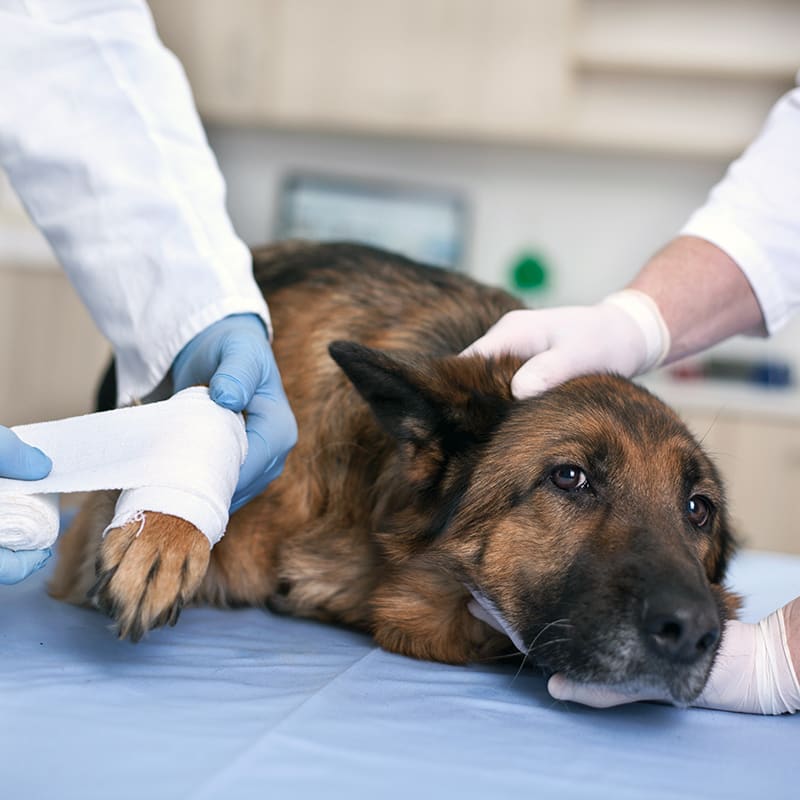Homeward Hopelessness or Hidden Hurt? Treating a Limping Dog Safely
The sight of your beloved canine companion limping can send shivers down any pet owner’s spine. Whether it’s a sudden yelp after a playful jump or a gradual decline in mobility, a limping gait warrants attention. This guide delves into the potential causes of limping in dogs, explores safe and effective home treatment options for mild cases, and emphasizes the importance of seeking veterinary guidance when necessary.
Unveiling the Ursache (Cause): Exploring Reasons Behind a Limping Dog
Limping in dogs can stem from various underlying issues, ranging from minor injuries to more serious conditions. Here’s a breakdown of some common culprits:
- Muscle Strain or Sprain: This is a common cause, especially after exercise or playtime. The dog might favor the affected leg and show signs of pain when touched.
- Dislocated Joint: A dislocated joint is a more serious issue where the bones pop out of their normal position. It’s often accompanied by intense pain, swelling, and an inability to bear weight on the affected leg.
- Fracture: A broken bone can cause a sudden and severe limp. The dog might whimper or yelp in pain and be unable to put any weight on the leg.
- Arthritis: This degenerative joint disease is more common in older dogs and can cause chronic limping, stiffness, and pain.
- Paw Pad Injury: Cuts, punctures, or foreign objects lodged in the paw pad can cause limping and discomfort.
- Infection: Infections in the bone, joints, or soft tissues can lead to limping, swelling, and fever.
The Importance of Observation: When to Seek Veterinary Attention
While some cases of limping might seem manageable at home, it’s crucial to seek veterinary attention promptly if you notice any of the following signs:
- Severe pain: If your dog yelps or whines when touched or tries to avoid putting any weight on the leg, it’s a clear sign of significant pain and requires professional evaluation.
- Swelling: Noticeable swelling around the affected joint or limb indicates potential damage and warrants veterinary assessment.
- Deformity: If the leg appears visibly deformed, bent at an unnatural angle, or has an unusual bulge, seek immediate veterinary care.
- Loss of appetite or lethargy: These symptoms, coupled with limping, could indicate a more serious underlying condition.
- Open wounds or bleeding: Any open wounds or significant bleeding require immediate veterinary attention to prevent infection.
Homeward Bound Healing: Safe and Supportive Care for Minor Limps
For mild cases of limping, where your dog exhibits minimal pain and seems otherwise comfortable, here are some home care strategies you can implement:
- Rest and Restriction: Limit your dog’s activity to prevent further injury. Leash walks for bathroom breaks might be necessary, but avoid playtime or strenuous exercise.
- Cold Therapy: Apply an ice pack wrapped in a towel to the affected area for 15-minute intervals several times a day. This can help reduce inflammation and pain.
- Warm Therapy: After the initial inflammation subsides, consider applying warm compresses to improve circulation and promote healing.
- Supportive Bandaging (with caution): For sprains or minor injuries, a light bandage might offer support, but ensure it’s not too tight and allows for proper circulation. It’s crucial to consult a veterinarian before applying any bandages to avoid restricting blood flow.
- Pain Relief Medication (with caution): Never administer any over-the-counter pain medication to your dog without consulting a veterinarian. Human medications can be toxic to dogs.
Remember: Home care is only suitable for mild, non-weight-bearing limping of short duration.
FAQ: Frequently Asked Questions about Treating a Limping Dog at Home
- Q: Can I massage my dog’s limping leg?
A: For minor sprains, gentle massage after the initial inflammation has subsided might be helpful. However, it’s best to consult your veterinarian for guidance on proper massage techniques and to rule out any serious injuries.
- Q: Should I elevate my dog’s leg?
A: Elevating the affected leg above the heart level can help reduce swelling. You can use pillows or towels to create a comfortable support system.
- Q: How long should I wait before taking my dog to the vet?
A: If the limping persists for more than 24-48 hours, worsens, or is accompanied by any other concerning signs like swelling, pain, or loss of appetite, seek veterinary attention immediately.






More Stories
Where to Watch USMNT vs Jamaica National Football Team
How I Met My Monster
How Should a Ring Fit